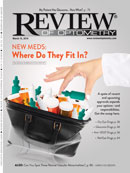“While classification of glaucoma severity is critical for clinical management, there is no single staging system that has been universally adopted for our clinical use,” Tran Bianconi, OD, noted in a presentation yesterday at the Academy 2018 meeting in San Antonio. This is where her team stepped in.
They conducted a study to explore the viability of creating a glaucoma staging system using vision-related quality of life scores, and found that bilateral 24-2 visual field index scores correspond well with the stage of glaucoma a patient is experiencing.
The study evaluated 206 eyes of 103 primary open-angle glaucoma patients. The researchers administered NEI-VFQ-25 questionnaires to measure patient quality of life, and participants completed 24-2 and 10-2 visual field testing within six months of completing the questionnaire. The team then compared visual field summary metrics (mean deviation and pattern standard deviation for 24-2 and 10-2, and visual field index for 24-2) across the vision-related quality of life (VR-QOL)-based stages to investigate the utility of these variables in distinguishing between stages.
The researchers assessed field loss in the group as follows: 28% unaffected, 24% mild field loss, 18% moderate loss and 30% severe loss. When visual field metrics were compared with quality of life stage, the team found that 24-2 visual field index value was the only parameter significantly different between stages. Lower, intermediate and higher vision-related quality of life scores were associated with these respective mean visual field index scores: <85%, 85% to 94% and >94%.
The study concludes that average index scores may estimate patient-specific vision-related quality of life, which has been shown to correlate with glaucoma severity and could be used to develop a universal glaucoma staging system.
| Bianconi TN, Sullivan-Mee M, Pensyl D Katiyar S. Employing Vision-related Quality of Life Scores to Construct a Glaucomatous Visual Field Loss Staging System. Academy 2018 San Antonio |

